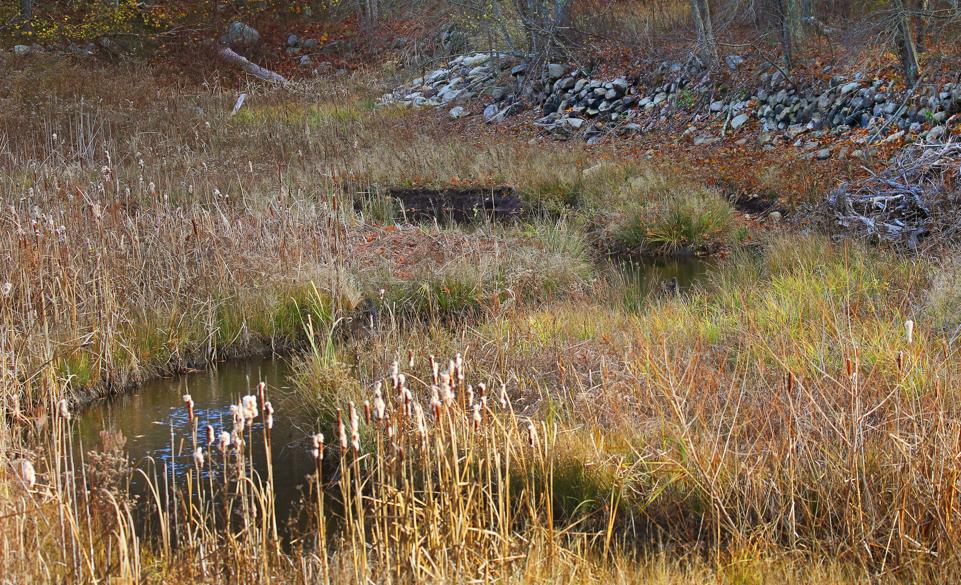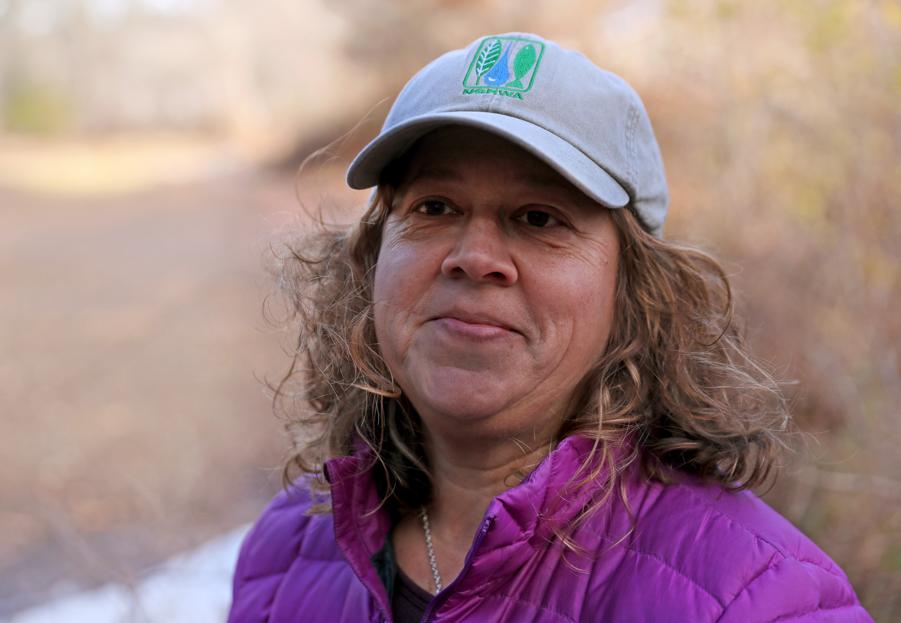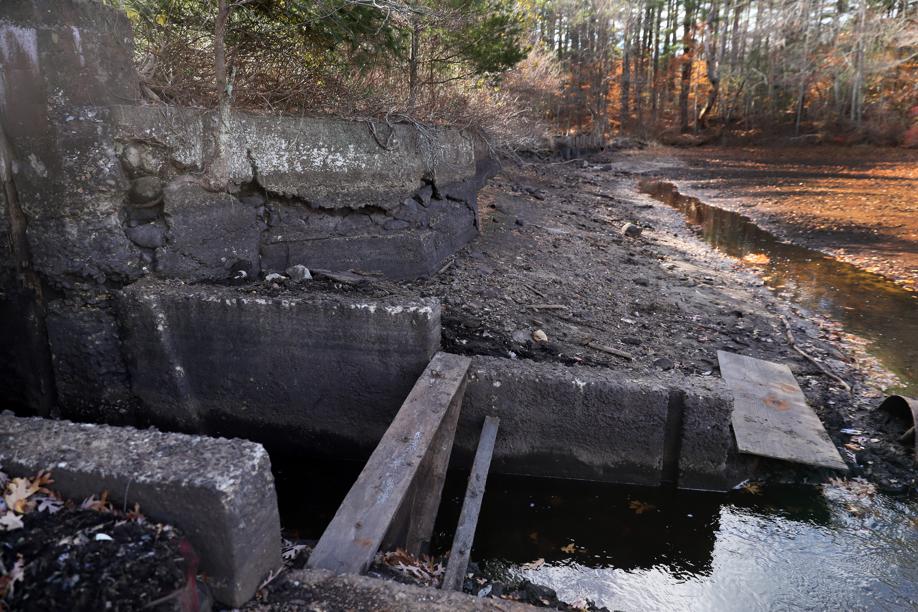


NORWELL — Third Herring Brook winds through a plain of dark, cracked silt that once formed the bottom of the pond behind the Tack Factory Dam.
There’s not much of the pond left and, soon enough, there will be no pond at all. Workers are preparing to demolish the dam, leaving the narrow stream to cut a new path across a landscape where it has not flowed freely since 1674.
The project will remove a crumbling piece of infrastructure that once helped drive industry in the area. In its wake, more than eight miles of stream will be allowed to flow free again, creating new habitat for the herring that give the brook its name.
“People are starting to realize that rivers have intrinsic value,’’ said Samantha Woods, executive director of the North & South Rivers Watershed Association, which is leading efforts to remove dams. “To see them being restored as nature intended them to be is pretty profound.’’
The association’s effort comes amid a push in Massachusetts and across the country to remove dams that no longer serve the purpose that led to their construction. About 3,000 dams dot the state, environmental officials say, but just 10 to 15 percent remain in active use.
Many of the dams are little more than mounds of soil and rock that can be costly and complicated to raze. Over the past 15 years, more than 30 dams have been removed in Massachusetts, and up to 30 projects are in planning at any given time.
Though they often no longer have any immediate purpose, dams — and the ponds they create — have become a part of the aesthetic landscape of the communities that surround them. In Norwell, neighbors said they’ll be sorry to see the Tack Factory Dam go.
“It was a very popular spot. People ice skate there,’’ said Warren M. Childs, whose property backs up to the former edge of the pond. “It was a great place for kids to go, just to explore around the pond, look for frogs, turtles, things like that.’’
He said some neighbors disputed the need to get rid of the dam, arguing the pond had its own ecosystem that would be disrupted by the change. But Childs and his wife ultimately decided there was nothing to be done.
“We’d prefer to have the pond there, but I think most people recognize that these dam removals are happening, and we’re trying to make the best of it,’’ he said.
The dam is now owned by the nonprofit Cardinal Cushing Centers. Workers used to make tacks on the site, but it had shut down long before it burned in 1983.
Under state law, owners are liable for injuries and damage caused by dam failures, which provides another incentive for them to work toward taking them down.
State officials and groups such as the watershed association try to push the process along by offering help to plan and pay for demolition. In the case of the Tack Factory Dam, state, federal, and private grants helped the owner pay for the $420,000 project.
Massachusetts is among only a handful of states that have dedicated staff to help owners with dam removal, and the work is starting to make headway, according to Beth Lambert, aquatic habitat restoration program manager in the state Department of Fish and Game.
“Interest is definitely growing,’’ she said. “We get more calls from dam owners every year than we can provide assistance to.’’
A 2005 crisis involving Taunton’s Whittenton Pond Dam helped highlight the issues presented by the state’s inventory of aging dams.
That structure was on the verge of collapse after a period of heavy rain, drawing national attention as the specter of a catastrophic flood loomed over downtown Taunton. Workers were able to shore it up before it was demolished in 2013, but the lessons reverberated, Lambert said.
“That really raised the awareness of the failing dams,’’ she said.
Another dam on Third Herring Brook gave the watershed association its first opportunity to try a removal in the river system that flows into the North River.
The group had been working to gather support for such a project for more than a decade before it took down the Mill Pond Dam in 2014.
It was an encouraging project, said Woods, of the watershed association, but it had nowhere near the ecological benefit of the Tack Factory project, which is downstream and blocks fish from swimming into Wildcat Brook, Silver Brook, and other waters.
The demolition should be done by the end of the year, after workers scoop enough of the earth away to make room for the brook to flow through in perpetuity.
Woods said she believes the project will make a difference for the herring population, a food source that helps sustain offshore fisheries for cod, tuna, striped bass, and other commercial catches.
Some argue that the construction of fish ladders, which allow fish to traverse dams, could help the herring get upstream while keeping dams and ponds in place. But Woods believes that it is best to remove the man-made structures blocking the water. As she puts it, “Fish like rivers.’’
On a recent morning, Woods drove over to where the Mill Pond Dam had been. In contrast to the bare landscape left behind by the pond at Tack Factory, the brook at Mill Pond flows through cattails and grasses that sway in the breeze.
Eventually, a similar scene will grow at the newly cleared site downstream, she said.
Lambert said she understands it is hard for people to say goodbye to the ponds that have been a part of their landscapes for generations, but she said successful projects create a different kind of natural beauty.
“After the dam goes out and the natural river reestablishes itself, the neighbors really enjoy that also,’’ she said. “They enjoy the sound of the moving water as it trickles over the rocks, and in the end they really like the project. It’s just really difficult for people to imagine that in advance.’’
Andy Rosen can be reached at andrew.rosen@globe.com. Follow him on Twitter at @andyrosen.



